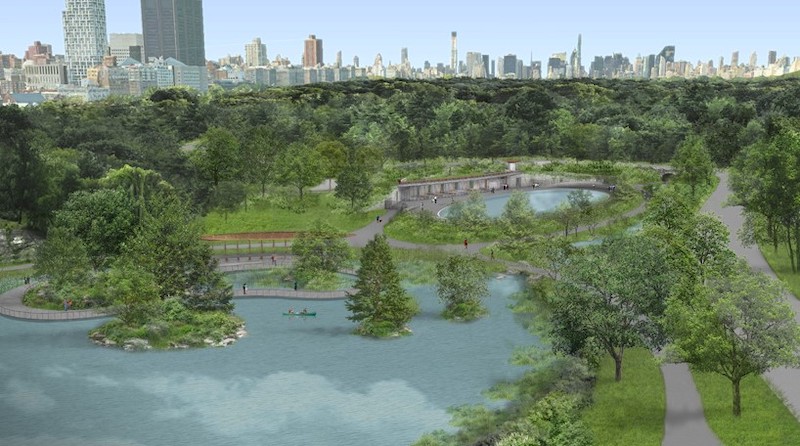The Central Park Conservancy has recently released details about the renovation of the Lasker Rink and Pool, the capstone project of the Conservancy’s 40-year campaign to restore Central Park. The project will restore the area’s ecosystem while creating a new pool and rink facility at the Harlem Meer.
The new facility will be integrated into the landscape by being built into the eastern side of the site with a green roof overlooking the area. It will be more open and accessible to visitors and, for the first time, the facility will support programming, access to restrooms, and amenities year-round.

A new pool and outdoor splash pad will be built and a seasonal ice rink for skating and hockey will be installed. A boardwalk, accessed via an open-air pavilion on the shoreline, that travels through a series of small islands and a freshwater marsh will convert to a skating ribbon in winter.

The existing Lasker Rink and Pool has acted as a physical and visual barrier to the north end for more than 60 years as it severed the Ravine landscape and Lock watercourse from the Harlem Meer. The new design provides unhindered access across to the north end of the Park by reconnecting the watercourse that runs through the Ravine so it flows freely into the Harlem Meer and by re-establishing the pedestrian path that once ran alongside it.
See Also: KPF-designed CITIC tower is Beijing’s tallest
The project, slated to begin in spring of 2021, has a budget of $150 million, which includes a $40 million maintenance and capital repair fund. The City of New York has allocated $50 million to the project. The conservancy is committed to raising the remaining $100 million and overseeing the design and construction. The project is slated for completion in 2024.
Related Stories
Urban Planning | Jul 26, 2023
America’s first 100% electric city shows the potential of government-industry alignment
Ithaca has turned heads with the start of its latest venture: Fully decarbonize and electrify the city by 2030.
Multifamily Housing | Jul 25, 2023
San Francisco seeks proposals for adaptive reuse of underutilized downtown office buildings
The City of San Francisco released a Request For Interest to identify office building conversions that city officials could help expedite with zoning changes, regulatory measures, and financial incentives.
Sustainability | Jul 13, 2023
Deep green retrofits: Updating old buildings to new sustainability standards
HOK’s David Weatherhead and Atenor’s Eoin Conroy discuss the challenges and opportunities of refurbishing old buildings to meet modern-day sustainability standards.
Multifamily Housing | Jul 11, 2023
Converting downtown office into multifamily residential: Let’s stop and think about this
Is the office-to-residential conversion really what’s best for our downtowns from a cultural, urban, economic perspective? Or is this silver bullet really a poison pill?
Adaptive Reuse | Jul 10, 2023
California updates building code for adaptive reuse of office, retail structures for housing
The California Building Standards Commission recently voted to make it easier to convert commercial properties to residential use. The commission adopted provisions of the International Existing Building Code (IEBC) that allow developers more flexibility for adaptive reuse of retail and office structures.
Office Buildings | Jun 28, 2023
When office-to-residential conversion works
The cost and design challenges involved with office-to-residential conversions can be daunting; designers need to devise creative uses to fully utilize the space.
Resiliency | Jun 14, 2023
HUD offers $4.8 billion in funding for green and resilient building retrofit projects
The Department of Housing and Urban Development (HUD) recently released guidelines for its Green and Resilient Retrofit Program (GRRP) that has $4.8 billion for funding green projects.
Energy-Efficient Design | Jun 5, 2023
Implementing an ‘asset drawdown strategy’ for site decarbonization
Solidifying a decarbonization plan via an “asset drawdown strategy” that carefully considers both capital and operating costs represents a game-changing opportunity for existing properties to compete with new projects.
K-12 Schools | Jun 5, 2023
How to achieve cost-effective kindergarten classrooms
Educational architect Robin Randall shares realistic advice about the challenges of adding developmentally appropriate, play-based kindergarten classrooms while respecting budget limitations.
Reconstruction & Renovation | May 26, 2023
Boulder, Colo., puts sustainable deconstruction policy into action
Three quarters of a closed hospital’s building materials and equipment are being reused for new construction, or resold.
















